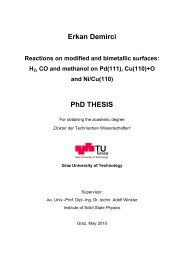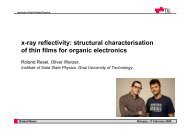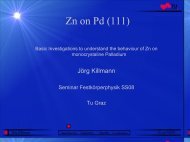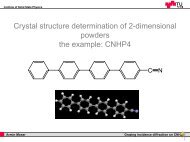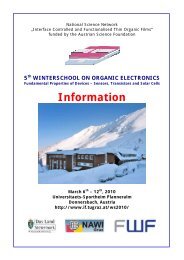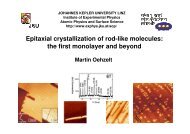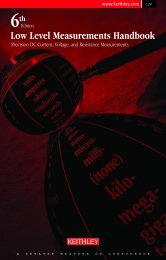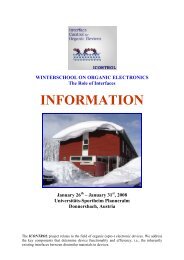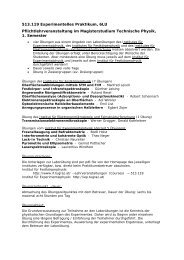Very Sharp Platinum Tips by Electrochemical Etching
Very Sharp Platinum Tips by Electrochemical Etching
Very Sharp Platinum Tips by Electrochemical Etching
Create successful ePaper yourself
Turn your PDF publications into a flip-book with our unique Google optimized e-Paper software.
3 Experimental methods Martin Kupper 0830965Figure 3.4: A well etched tip compared to a tip etched with an over-usedCaCl 2 /H 2 O/acetone solution.solution is no longer the surface of the solution, but rather the membrane of one ormore bubbles. That means that the contact is higher than the solution surface andthere<strong>by</strong> the sharp part of the tip is etched away. Such a tip is shown in Fig. 3.4. Howmany tips can be etched before changing the solution depends on how deep the Pt/Irwire is dipped into the solution, so on how much material is etched away. For etching4 tips which were dipped in the wire about 1 mm, a solution of 17 - 20 ml was used.It wasn’t possible to make more than 5 tips without changing the solution.After etching, the tips should be cleaned with distilled water. They should be dippedin a bowl filled with water, and moved left and right a little bit. If done carefully, theycan be flushed, if the water is allowed to flow too quickly while flushing, the tips caneasily be bent.After the etching step the tips are usually around 200 nm thick with a slim shape(seeFig. 3.5).3.3 AnnealingThe annealing is carried out for two reasons. Firstly, the surface of the tip after theetching is not very smooth (see Fig. 3.5). But more importantly, the heating of the tipreduces the amount of dislocations in the Pt/Ir, and there<strong>by</strong> the grains in the materialget bigger [2]. Thus the elastic properties of the tip are changing. An unannealed tipjust bends if it is pressed on a surface. This will be discussed in section 4.1.The annealing was done with a bunsen-burner, the wire was heated to red-heat for10 - 20 s. This step slightly enlarged the diameter of the tip (see Fig. 3.6).Test of the elastic properties were tested <strong>by</strong> bending one tip at the right edge of thesilicon sample which was in the SEM at this time (see Fig. 3.7). The elastic propertieswere not as bad as expected. The tip was deformed, but after taking the tip awayfrom the silicon it bent back to a certain value.9



